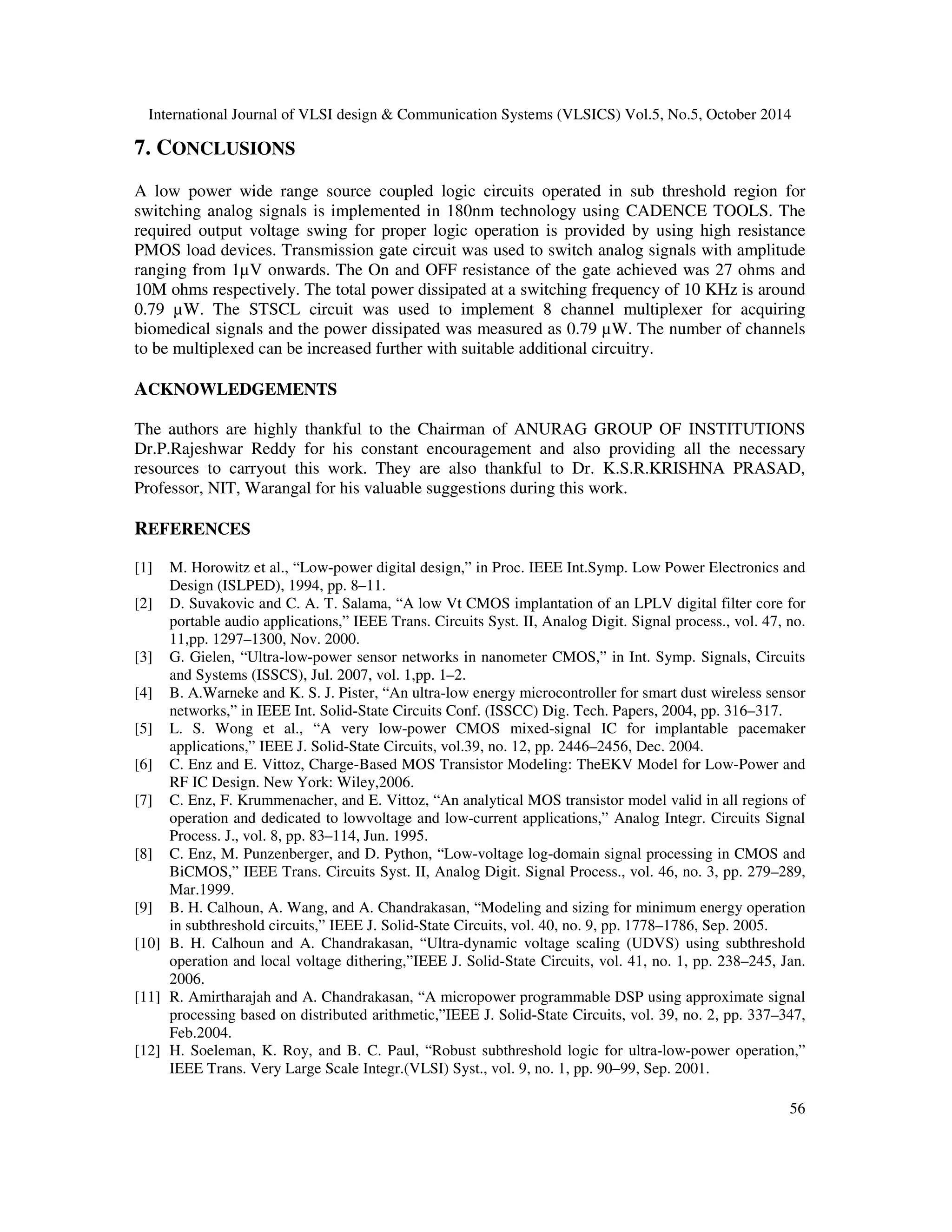The document presents a novel low-power CMOS analog multiplexer design using sub-threshold source-coupled logic (STSCL), achieving low power dissipation around 0.79 μW and high dynamic range. The multiplexer operates at a supply voltage of 400 mV with bias currents in the picoampere range, making it suitable for applications in biomedical engineering and other low-power environments. Additionally, the design incorporates techniques like dynamic body biasing to enhance performance and minimize power consumption further.
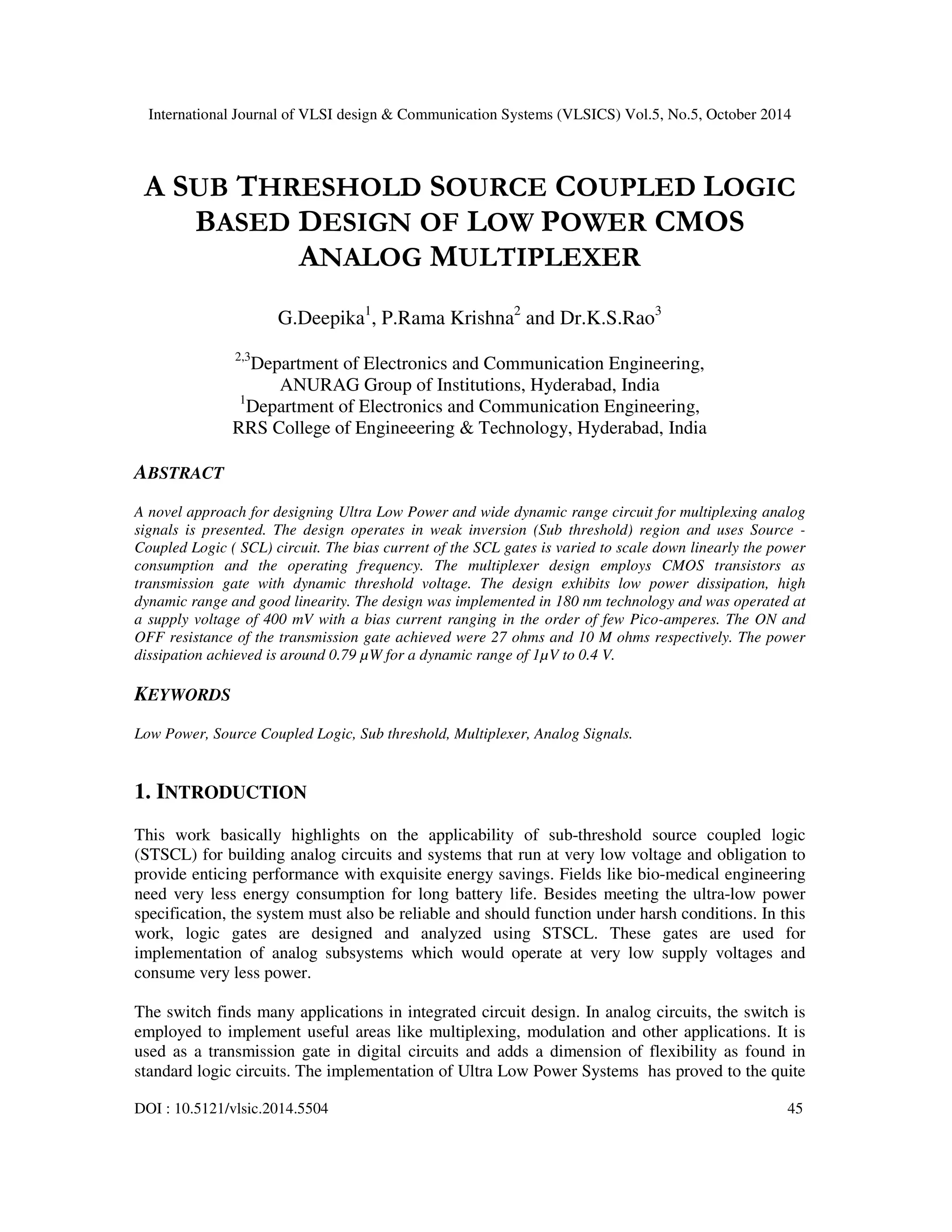
![International Journal of VLSI design & Communication Systems (VLSICS) Vol.5, No.5, October 2014
pivoted in many modern applications in many areas like mobile systems [1],[2] , sensor
networks[3],[4], and implantable biomedical applications [5]. Low power has gained more
importance in today’s electronics industry. The Necessity for low power has caused a major
paradigm shift where power dissipation has become significant consideration in performance and
area wise.
CMOS switches have great characteristics and in its most important form, a voltage-controlled
resistor which offers very low resistance less than 100 in its ON state and very High resistance
of several hundreds of Mega ohms in OFF state with Pico-ampere leakage currents. CMOS
technology is compatible with logic circuitry and integrates large number of ICs. [6]. Its fast
switching characteristics are well controlled with minimum circuit leakage. MOSFET transistors
can switch positive and negative voltages and conduct positive and negative currents with equal
ease.
Implementation of high performance systems especially for low power applications creates many
challenges and requires the trade off among speed of operation, power consumption, supply
voltage and device parameters such as threshold voltage and oxide thickness in conventional
CMOS technology.
When the MOSFET is in sub threshold operation the trans conductance to bias current ratio of
the transistor is maximum and the current density is very low [7], [8]. On the other hand, for
implementing widely adjustable circuits the exponential relationship between drain current and
gate voltage makes this mode of operation well suited [7], [9]. The dynamic (switching) power
consumption which is quadratic ally dependent on the supply voltage will cause the CMOS logic
circuits utilizing sub threshold region transistors operate with a very low power consumption
[10]–[13]. Therefore reduction in supply voltage reduces power dissipation and also output
voltage swing [1], [14] thereby increasing the delay in each gate. This means the power
dissipation, logic swing, and speed of operation are related to each other. The control of power
consumption becomes difficult due to the exponential relation between power dissipation and
supply voltage in sub threshold region. To implement very low power systems it is necessary to
minimize the power dissipation at the system level in addition to the gate level for achieving
desired performance [10].
This paper presents a new topology for implementing analog switch for ultra low power
applications. For achieving this a novel approach for implementing Source Coupled Logic (
SCL) circuits biased in sub threshold region is described. The speed of operation is independent
of supply voltage and threshold voltage of devices. In addition the current consumption in each
cell can be brought down to few pico- Amperes. It is therefore possible to reduce the system
power consumption well below the sub threshold leakage current of conventional CMOS circuits.
To enable operation at very low current levels and to attain the desired performance
specifications, special circuit techniques have to be applied for implementing very low power
SCL circuits.
The work focuses on the technique for implementing sub threshold (STSCL) gates where the bias
current of each cell can be set as low as 10pA. A brief review of SCL circuits, the proposed
technique for implementing the low power analog switch using sub threshold SCL gates, power
consumption and experimental results are described in the following sections.
46](https://image.slidesharecdn.com/5514vlsi04-141111012142-conversion-gate01/75/A-Sub-Threshold-Source-Coupled-Logic-Based-Design-of-Low-Power-CMOS-Analog-Multiplexer-2-2048.jpg)
![International Journal of VLSI design Communication Systems (VLSICS) Vol.5, No.5, October 2014
47
2. SUBTHRESHOLD SOURCE-COUPLED LOGIC CIRCUITS
The speed of operation in an SCL gate is inherently high as the logic operation mainly takes place
in current domain. An NMOS source coupled differential pair transistors acts as a switch to steer
the tail current Iss to one of the output depending on the input logic. The Load resistor RL
converts this current to output voltage to drive the other SCL gates. In order to switch the input
differential pair of the next stage the output voltage swing ( RL ISS ) should be adequately high.
Based on this the drain source over drive voltage input pair should be larger than 2 n Vdssat when
Vin = 0.
Fig. 1. Source Coupled Logic-based inverter/buffer circuit.
A source coupled logic based inverter/ buffer circuit is shown in FIG 1. More complex logic
functions can be implemented by using a complex network of NMOS source coupled pairs as
switching part [7,13]. The load resistance RL is implemented by biasing the PMOS device in
triode region and also NMOS switching network should be arranged in a proper way to achieve
desired logic operation. The input logic level steers the tail bias current into one of the branch of
the source coupled pair and this current is converted to voltage by the load resistance. The DC
response of the SCL circuit is given in FIG 2.
Operating In sub threshold region, the device trans conductance does not depend upon the device
size but strongly depends on the temperature through UT. Hence by changing the design
parameters it is not possible to change the transfer curve [12].](https://image.slidesharecdn.com/5514vlsi04-141111012142-conversion-gate01/75/A-Sub-Threshold-Source-Coupled-Logic-Based-Design-of-Low-Power-CMOS-Analog-Multiplexer-3-2048.jpg)
![International Journal of VLSI design Communication Systems (VLSICS) Vol.5, No.5, October 2014
48
FIG 2. DC response of the SCL circuit.
The voltage swing and the current required for charging and discharging the parasitic
capacitances is less in SCL topology, when compared to the CMOS topology where the signal
swing is equal to VDD. The major advantage in SCL topology is reduction in signal swing. In
order to make the tail bias current completely switch to one of the two output branches, the
voltage swing at the input and output of a logic circuit should be high enough. The voltage swing
at the output node is given as
VSW = RL . ISS
should be adequately high to switch completely the input differential pair of the next stage. In
other words SCL circuit can be used as a logic circuit with allowable noise margin if its gain is
sufficiently high. The region of operation of the NMOS devices [17,18] gives the minimum
allowable voltage swing at the output of each SCL gate.
,= 2 ∙](https://image.slidesharecdn.com/5514vlsi04-141111012142-conversion-gate01/75/A-Sub-Threshold-Source-Coupled-Logic-Based-Design-of-Low-Power-CMOS-Analog-Multiplexer-4-2048.jpg)
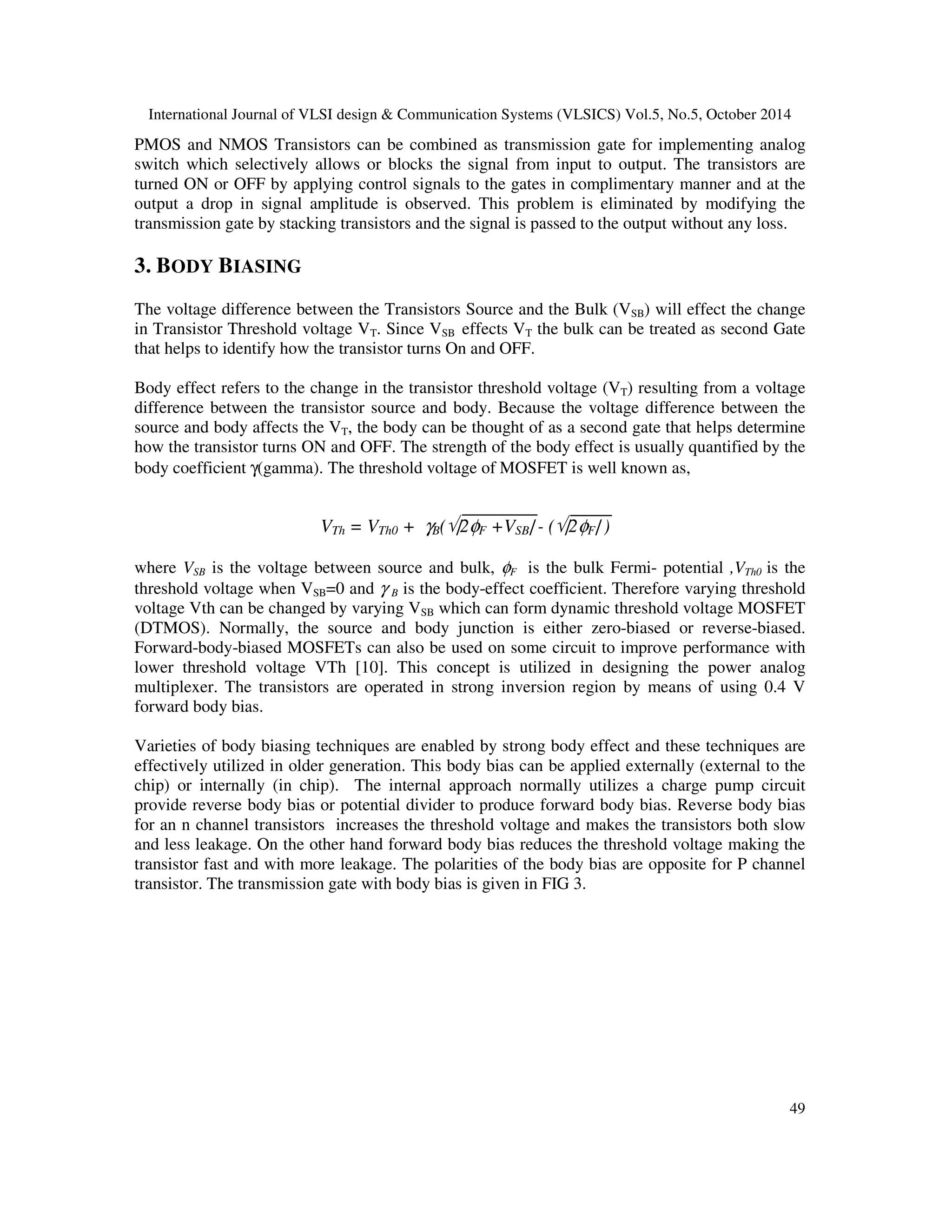
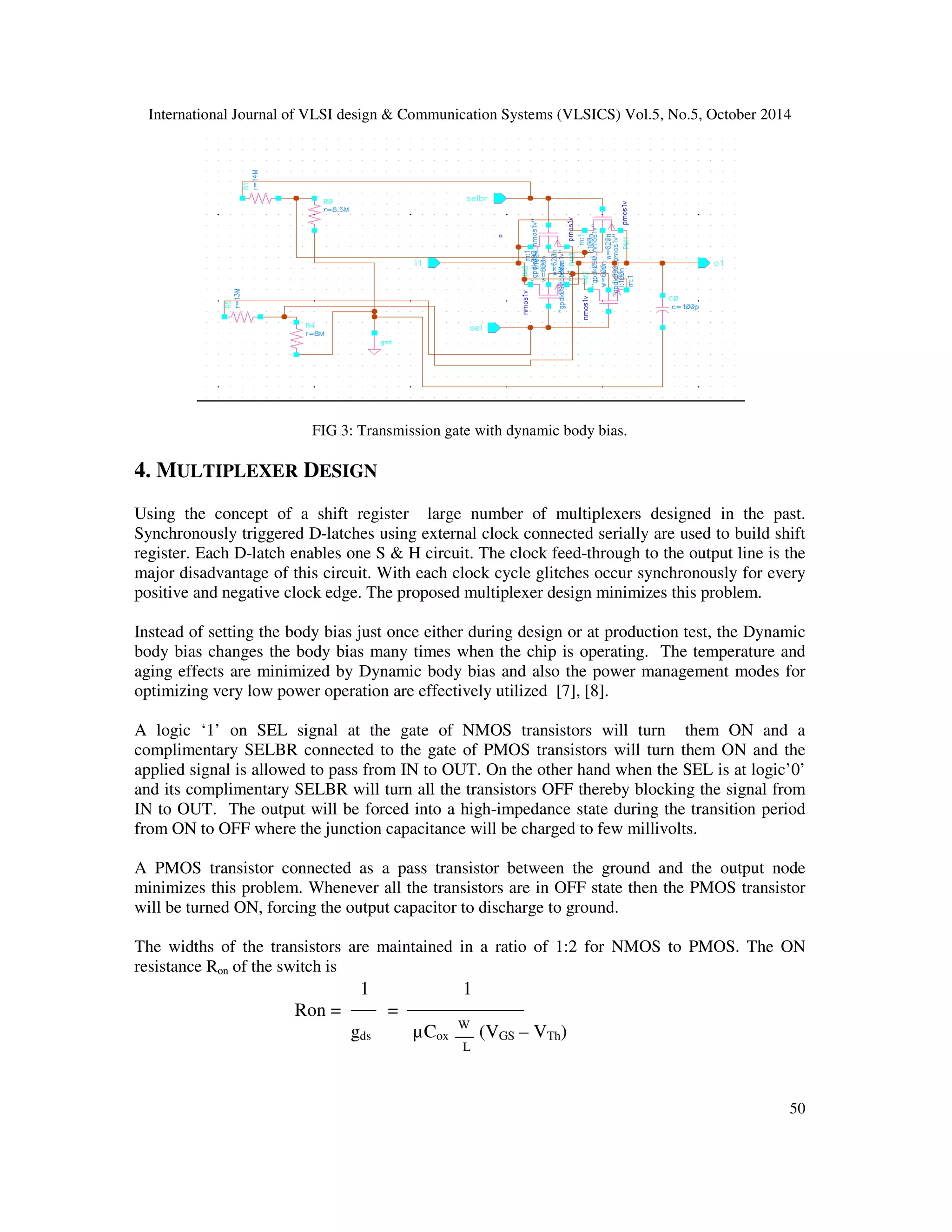
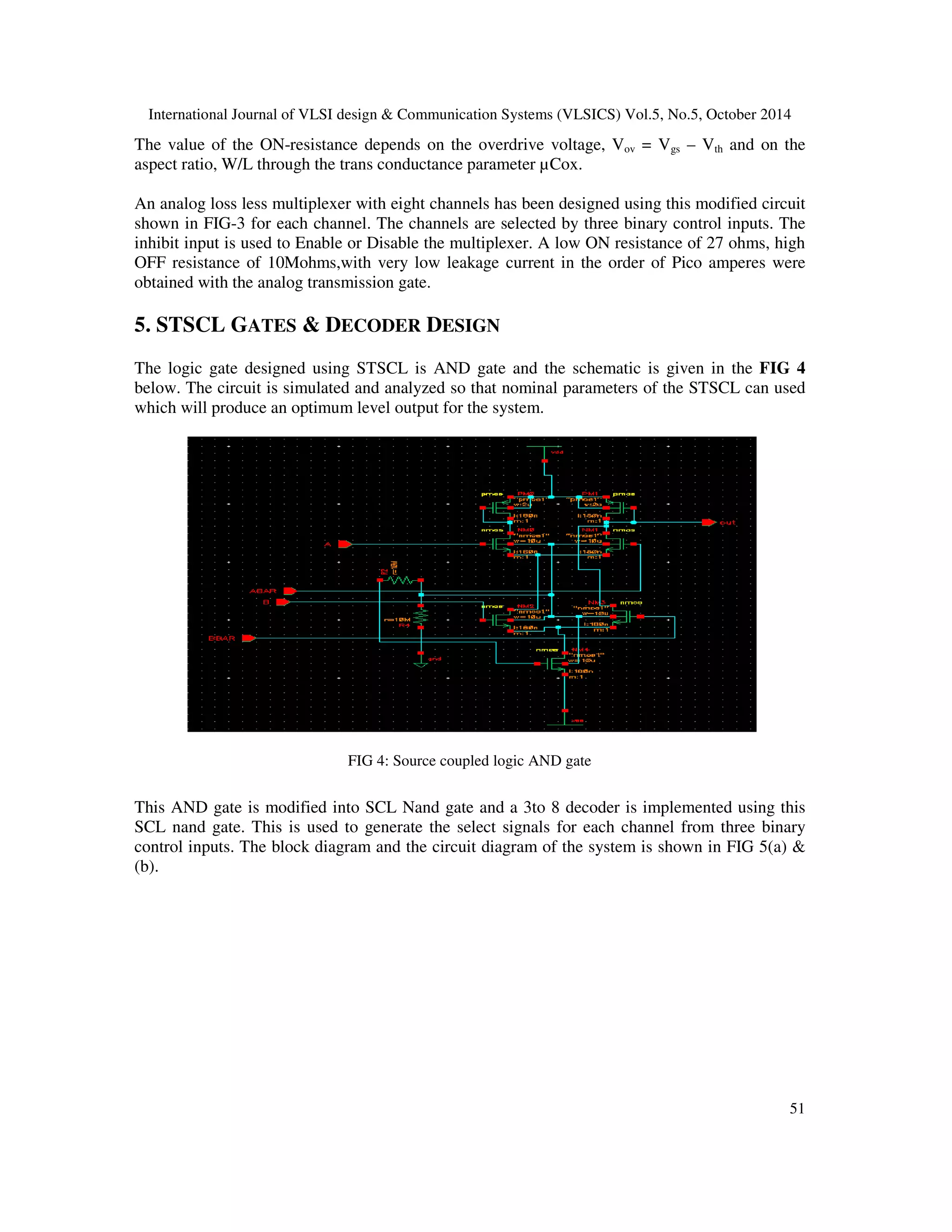
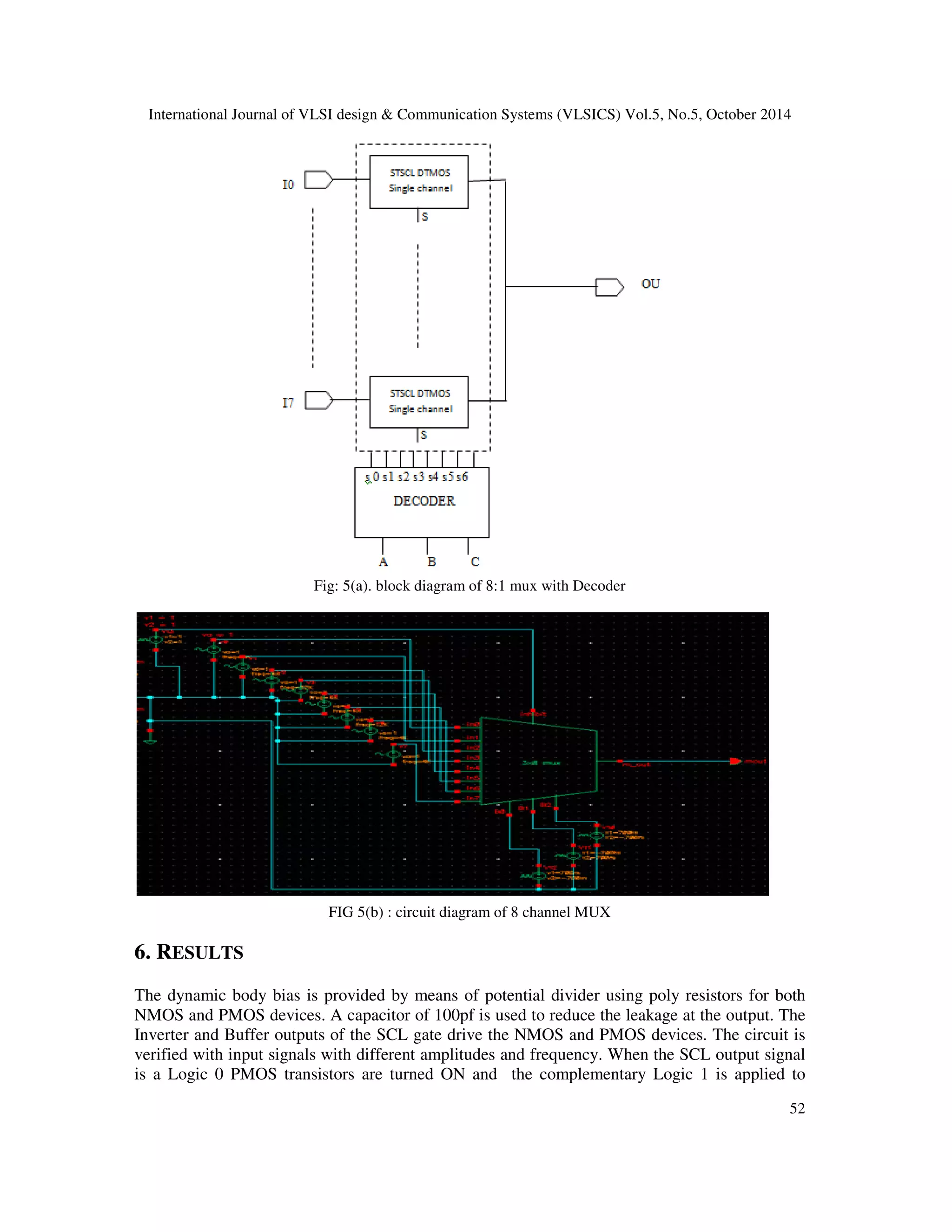

![International Journal of VLSI design Communication Systems (VLSICS) Vol.5, No.5, October 2014
PMOS and NMOS Transistors can be combined as transmission gate for implementing analog
switch which selectively allows or blocks the signal from input to output. The transistors are
turned ON or OFF by applying control signals to the gates in complimentary manner and at the
output a drop in signal amplitude is observed. This problem is eliminated by modifying the
transmission gate by stacking transistors and the signal is passed to the output without any loss.
49
3. BODY BIASING
The voltage difference between the Transistors Source and the Bulk (VSB) will effect the change
in Transistor Threshold voltage VT. Since VSB effects VT the bulk can be treated as second Gate
that helps to identify how the transistor turns On and OFF.
Body effect refers to the change in the transistor threshold voltage (VT) resulting from a voltage
difference between the transistor source and body. Because the voltage difference between the
source and body affects the VT, the body can be thought of as a second gate that helps determine
how the transistor turns ON and OFF. The strength of the body effect is usually quantified by the
body coefficient g(gamma). The threshold voltage of MOSFET is well known as,
VTh = VTh0 + gB(Ö|2fF +VSB| - (Ö|2fF| )
where VSB is the voltage between source and bulk, fF is the bulk Fermi- potential ,VTh0 is the
threshold voltage when VSB=0 and g B is the body-effect coefficient. Therefore varying threshold
voltage Vth can be changed by varying VSB which can form dynamic threshold voltage MOSFET
(DTMOS). Normally, the source and body junction is either zero-biased or reverse-biased.
Forward-body-biased MOSFETs can also be used on some circuit to improve performance with
lower threshold voltage VTh [10]. This concept is utilized in designing the power analog
multiplexer. The transistors are operated in strong inversion region by means of using 0.4 V
forward body bias.
Varieties of body biasing techniques are enabled by strong body effect and these techniques are
effectively utilized in older generation. This body bias can be applied externally (external to the
chip) or internally (in chip). The internal approach normally utilizes a charge pump circuit
provide reverse body bias or potential divider to produce forward body bias. Reverse body bias
for an n channel transistors increases the threshold voltage and makes the transistors both slow
and less leakage. On the other hand forward body bias reduces the threshold voltage making the
transistor fast and with more leakage. The polarities of the body bias are opposite for P channel
transistor. The transmission gate with body bias is given in FIG 3.](https://image.slidesharecdn.com/5514vlsi04-141111012142-conversion-gate01/75/A-Sub-Threshold-Source-Coupled-Logic-Based-Design-of-Low-Power-CMOS-Analog-Multiplexer-10-2048.jpg)
![International Journal of VLSI design Communication Systems (VLSICS) Vol.5, No.5, October 2014
50
FIG 3: Transmission gate with dynamic body bias.
4. MULTIPLEXER DESIGN
Using the concept of a shift register large number of multiplexers designed in the past.
Synchronously triggered D-latches using external clock connected serially are used to build shift
register. Each D-latch enables one S H circuit. The clock feed-through to the output line is the
major disadvantage of this circuit. With each clock cycle glitches occur synchronously for every
positive and negative clock edge. The proposed multiplexer design minimizes this problem.
Instead of setting the body bias just once either during design or at production test, the Dynamic
body bias changes the body bias many times when the chip is operating. The temperature and
aging effects are minimized by Dynamic body bias and also the power management modes for
optimizing very low power operation are effectively utilized [7], [8].
A logic ‘1’ on SEL signal at the gate of NMOS transistors will turn them ON and a
complimentary SELBR connected to the gate of PMOS transistors will turn them ON and the
applied signal is allowed to pass from IN to OUT. On the other hand when the SEL is at logic’0’
and its complimentary SELBR will turn all the transistors OFF thereby blocking the signal from
IN to OUT. The output will be forced into a high-impedance state during the transition period
from ON to OFF where the junction capacitance will be charged to few millivolts.
A PMOS transistor connected as a pass transistor between the ground and the output node
minimizes this problem. Whenever all the transistors are in OFF state then the PMOS transistor
will be turned ON, forcing the output capacitor to discharge to ground.
The widths of the transistors are maintained in a ratio of 1:2 for NMOS to PMOS. The ON
resistance Ron of the switch is
1 1
Ron = =
gds μCox W (VGS – VTh)
L](https://image.slidesharecdn.com/5514vlsi04-141111012142-conversion-gate01/75/A-Sub-Threshold-Source-Coupled-Logic-Based-Design-of-Low-Power-CMOS-Analog-Multiplexer-11-2048.jpg)
